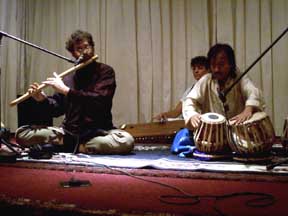Try this on for sighs.
The great-grandaddy of all psychedelic musics, the supreme bean of trippy scenes, the goalie host who I pause now to toast is Indian classical music. (I hear you muttering "bloody hippy" under your breath, you ingrate...)
I don't know if you're familiar with the drawn-out improvisations of this dozen(+) century-old artform, but you should aquaint yourself, for it is "high" art indeed: an orally-transmitted tradition steeped in rugged virtuosity fully devoted to the power of informed improvisation.
In India, nobody just plays "a little" sitar. Nobody "dabbles" on the tabla. If, as a child, you are chosen to be a musician, you surrender to discipleship, devotedly serving a recognized master for umpteen years (usually 7-10) making his food and cleaning his house (I'm serious) while he drives you before him like a musical slave, slowly molding your performance aesthetics through years of ruthless 12-16 hour-a-day practice sessions. These gurus-- though deeply loved-- are notoriously harsh and critical, and only the best, fastest, strongest and most confident apprentices go on to become performers. Needless to say, if you survive a boyhood bootcamp like that, you come out with some chops.
You need 'em. In Indian classical music, each piece (or "raga") has not only a particular melody, rhythm (or rhythms), and ascending and descending scales (for soloing), but also a time of day (or night) it is to be performed and a particular mood it is supposed to evoke-- usually a subtle aspect of love or devotion to God. All of this is very complex and scientific, and if you get an Indian classical musician talking about it, you will likely get an earful. Indian musicians (being super-fast and super-intense) and especially drummers (being also historically somewhat roguish), have a propensity to flaunt their prowess like a prized piece of antique heirloom jewelry. "Look: I can fit seven beats in the same space as four beats, watch... now five beats... now eleven..." It's a lovely thing to behold.
 |
|
wubbenhorst & burman |
A performance of a typical raga in India will often last 3-4 hours. Read that last sentence again and then imagine sitting cross-legged on the ground listening to two musicians improvise over the same piece of music for 3-4 hours. Makes your knees ache, doesn't it? Now imagine being able to play it. Now imagine how good you'd have to be to make it worth listening to. In India, favored musicians are revered like living treasure: distinguished gurus and nobility give them palaces to live in and holy people trance out during their performances, purportedly merging with the Divine.
No doubt in my mind: India produces some of the finest musicians in the world. So when I heard that the young (a mere 31 - just a pup) but very distinguished Calcuttan drummer, Sandip Burman, was coming to town, I set aside two nights to catch both of his shows.
Sandip Burman has been gaining some notoriety in the U.S. by sitting in with Bela Fleck, accompanying the fusionoid banjo player on the Indian tabla drums. (The amazingly psychedelic, warbly-bottommed, ringy-topped tabla drums-- yum-yum.) Of course, back home he is already highly regarded, having recieved patronage from Maharishi Mahesh Yogi and accompanied eminent sitarist Ravi Shankar.
In Charlottesville he was performing with D.C.-based bansuri (bamboo flute) player, John Wubbenhorst (a student of the beloved Hariprasad Chaurasia), with whom he has been doing some recording and touring. They'd added a couple dates to their tour schedule-- one at Kaliedescope (May 29) and one at the New Dance Space (May 30)-- just a couple nice showcases before they roll out to the Midwest to do some gigs with Bela Fleck's bassist Victor Wooten, arguably the baddest bass in the biz. Then it's off to do shows with jazz legend Jack Dejeanette, then maybe go hang out with Johns Scofield or McLaughlin... who knows?
"Sheesh!" I thought. What makes him so lucky?
 |
|
sandipji |
Oh yeah-- his chops. Reverent, enthusiastic and powerful, Sandip emanates charisma, silently listening and reacting during the solo flute "alap" that opens each piece and then throwing himself into the following musical jousts with gleeful intensity while Wubbenhorst works and reworks the raga's phrases on the haunting bamboo flute. Both shows opened with short versions of a traditional raga (only 45 minutes to an hour), and then turned to an Indian treatment of Bach's flute concertos (Wubbenhorst couldn't resist slipping in a brief hint of "Sunshine of Your Love"-- freak!) followed by an interesting raga variation involving rhythmic cycles of eight and a half beats.
Eight and a half beats and then seventeen beats and then four and one quarter and then two and then... Sandip is counting the measures so we can hear the "one" come around. Very impressive. It takes a long time to get used to odd meters like that-- to know exactly how they're supposed to feel. Indians hear them their whole lives-- in folk songs. I can't help thinking that if Sandip figures out to stay close to the relatively simple 4/4 cycles that we dumb westerners know so well, America would probably give him a palace to stay in, too. I would. If I had a spare. Namaskar.
-Cripsy Duck
cripsyduck@mindspring.com